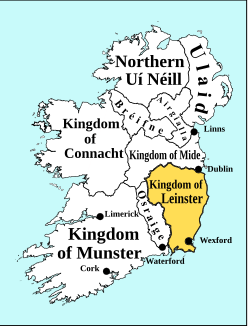
Back Roll rouaned Laighin Breton Reis de Leinster Catalan Liste des rois de Leinster French Ríthe na Laighean Irish Reis de Leinster Galician Daftar Raja Leinster ID Sovrani del Leinster Italian Władcy Leinsteru Polish Lista de reis de Leinster Portuguese Короли Лейнстера Russian
This article has multiple issues. Please help improve it or discuss these issues on the talk page. (Learn how and when to remove these template messages)
|
| Kings of Leinster | |
|---|---|
| Rí Laighin | |
 Map of Leinster, c. 10th century. | |
| Details | |
| Style | Rí Laighin |
| First monarch | Úgaine Mór |
| Last monarch | Domhnall Spáinneach Mac Murchadha Caomhánach |
| Formation | Ancient |
| Abolition | 1603 or 1632 (de facto) |
| Residence | Dún Ailinne |
| Appointer | Tanistry |
The kings of Leinster (Irish: Rí Laighín) ruled from the establishment of Leinster during the Irish Iron Age until the 17th century Early Modern Ireland. According to Gaelic traditional history found in works such as the Book of Invasions, Leinster was created during the division of Ireland among the Irish Gaels, descendants of Milesius: Leinster was one of the territories held by the offspring of Heremon. In the 7th century BC, the branch of the Heremonians who would establish Leinster, starting with Úgaine Mór, were also High Kings of Ireland and Kings of Tara. Their ascent to hegemony in Ireland was associated with the decline in influence of their Ulster-based Heremonian kinsmen from the Érainn.
Apart from Úgaine Mór, other prominent Kings of Leinster from this period who were also High Kings of Ireland were Labraid Loingsech and Cathair Mór. A mythology developed that Labraid Loingsech had horses ears: he spent some time exiled in Transalpine Gaul (dated roughly to the period of the Roman–Gallic wars) where his grandmother was from and returned to Ireland with Gaullish mercenaries. He established a base in the area, which was renamed from "Gailian" to Leinster, in reference to the pointed-spears held by the Gaullish Gaesatae mercenaries who provided the backbone of Labraid Loingsech's powerbase and brought him to the High Kingship. Cathair Mór, who was also a High King of Ireland, is perhaps the most important figure genealogically in Leinster as all of the subsequent kinship groups which ruled Gaelic Leinster claimed descent and legitimacy to rule from one of his ten sons who had offspring.
By the time of Early Christian Ireland, the Laighín had lost their grip on Irish hegemony with the rise of the descendants of Conn of the Hundred Battles (the Connachta and the Uí Néill). The latter pushed down into Leinster and created the Kingdom of Meath based at Uisnech, under the Southern Uí Néill from territories belonging to the Kingdom of Leinster and to the west Osraige was taken from the Laighín by the Corcu Loígde of Munster.
During the 5th to the early 8th centuries, the Kingship of Leinster was contested by various different branches of the Laighín, including the Uí Cheinnselaig (ancestors of the Mac Murchada and Caomhánach), the Uí Dúnlainge (ancestors of the O'Byrnes and the O'Tooles), the Uí Bairrche (ancestors of the Mac Gormáin), the Uí Máil (ancestors of the Ó Conchobhair Uí Failghe) and others.
From the 8th until the 11th century, the kingship of Leinster rotated in a remarkably stable arrangement between three branches of the North Leinster Uí Dúnlainge kinship, namelt the Uí Fáeláin (ancestors of the O'Byrnes), the Uí Muiredaig (ancestors of the O'Tooles) and the Uí Dúnchada (whose descendants became the MacGillaMoCholmóc and later the FitzDermots). In the 9th century, the Laighín also regained control of Osraige but it remained a largely independent realm under the Mac Giolla Phádrag, from the semi-autonomous Uí Failghe kinship group.
The Uí Cheinnselaig in South Leinster took back control of the kingship of Leinster in the 11th century, with Diarmait mac Máel na mBó, who became the first Leinsterman to be High King of Ireland in over a thousand years and claimed to the most senior line of the Laighín. An enemy of the Vikings of Dublin, he gave refuge to the sons of Harold Godwinson after the Normans conquered England. It is from this line that the Mac Murchada family originate and later Diarmait Mac Murchada would be implicated in the 12th century Norman invasion of Ireland after he tried to win back his Leinster throne. The reigning dynasty adopted the surname Caomhánach (Kavanagh) and continued to rule a rump Kingdom of Leinster until the early 17th century, with the last recorded King of Leinster being Domhnall Spáinneach Mac Murchadha Caomhánach. Throughout the centuries after the Norman invasion, several Kings and also leaders from dynasties who had previously held the Kingship of Leinster, continued to resist the invasion and hounded the English Pale periodically from the Wicklow Mountains: including the leaders of the O'Toole and O'Byrne clans (notable examples include Art Óg Mac Murchadha Caomhánach and Fiach McHugh O'Byrne) until the 17th century.
© MMXXIII Rich X Search. We shall prevail. All rights reserved. Rich X Search